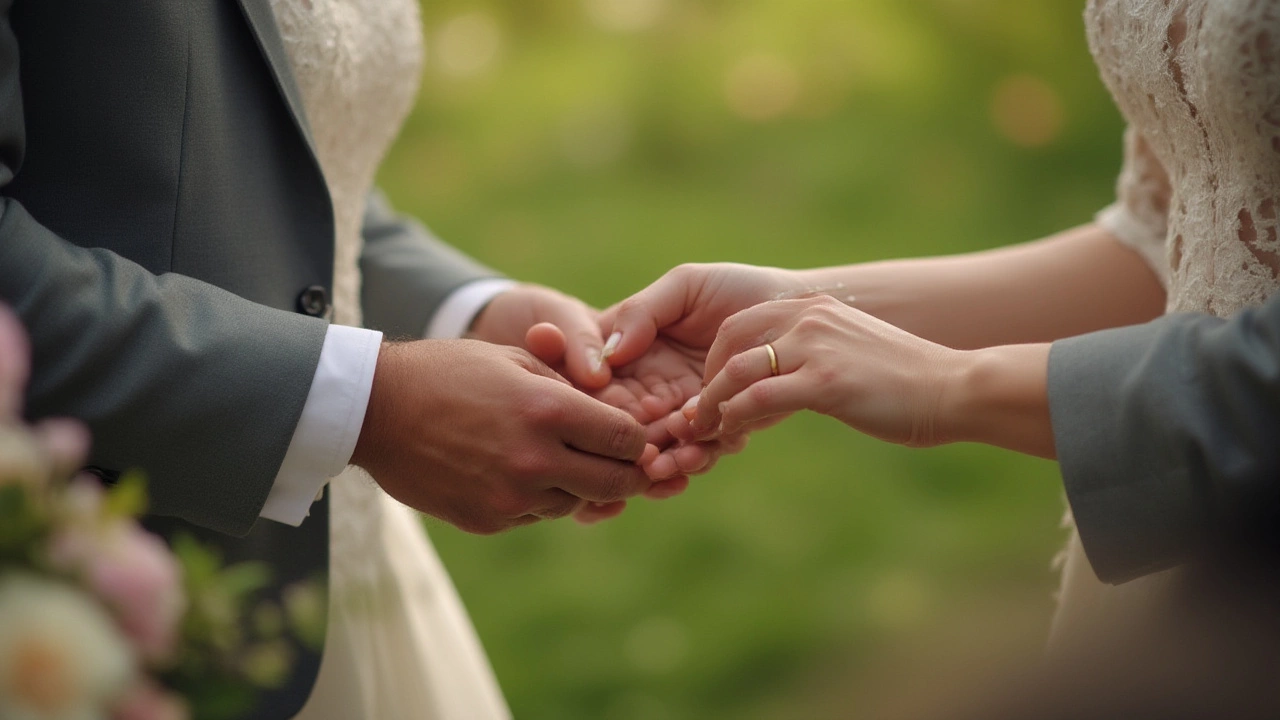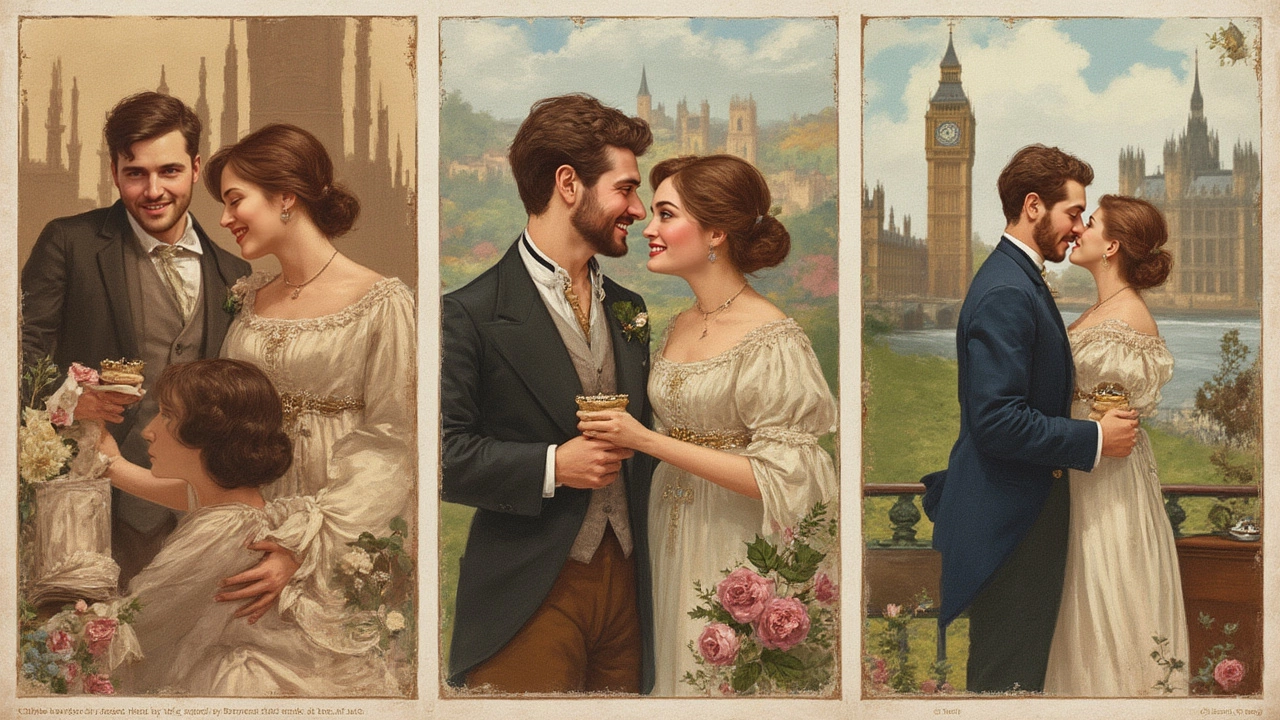Who Gives the Wedding Ring First? Modern Wedding Ring Exchange Traditions Explained
 Jul, 25 2025
Jul, 25 2025
Ever wondered if there’s a hidden rule about who gives the wedding ring first? You’re not alone. This tiny detail stirs up more wedding nerves and late-night Google searches than you’d think. Everyone talks about the dress or flowers, but when it comes to the actual ring exchange, suddenly the crowd hushes, the cameras zoom in, and everyone waits for the big reveal—who hands over their ring first? Missing your cue here is every couple’s shared nightmare. But guess what? This wedding tradition is less set in stone than you’d expect.
The Origins of the Wedding Ring Exchange
Long before anyone started discussing first dances or photo booths, couples exchanged rings as signs of commitment. The habit started in Ancient Egypt, where people believed circles symbolized eternity—no beginning, no end. They would braid reeds or leather into rings and slip them onto the fourth finger of the left hand, thinking a special ‘vein of love’ ran straight from there to the heart. Science has since ruined that myth, but the romantic lore stuck, and so did the tradition.
Fast forward to Rome, and the ring became a little less poetic and a little more legal. Roman men gave rings to mark ownership or intent—think of it less as saying, ‘I love you,’ and more as, ‘You’re spoken for.’ By the 9th century, Christian ceremonies solidified exchange rituals, with the groom giving the ring to the bride while referencing biblical scripture.
The double-ring exchange—the idea that both partners give rings—didn’t appear everywhere until the early 20th century. Before this, Western weddings usually involved only the bride receiving a ring. The U.S. helped popularize the exchange of rings after World War II, partly driven by savvy jewelry ads targeting servicemen heading overseas who wanted a tangible reminder of their vows. That’s less than 80 years ago! So if you’re fretting over tradition, just remember, it’s always been a work in progress.
Even today, ring-giving customs vary wildly across cultures. Greek Orthodox ceremonies bless the rings several times before the couple exchanges them. In some Jewish weddings, only the groom gives a ring, though many modern couples opt for double-ring ceremonies. In India, wedding rings aren’t even traditional—gifts like toe rings or necklaces take center stage instead. So the ‘who goes first’ question really depends on where you are and what feels right for you.
Quick interesting fact: Prince William and Kate Middleton’s royal wedding followed the classic British custom—only Kate received a ring. William chose to skip wearing a wedding band, which in the UK isn’t seen as odd at all.
Basically, the ring exchange order is more fluid than a champagne fountain at a fancy reception. Stressed out about doing it ‘right’? Relax. History says you’ve got options.
How Most Modern Ceremonies Handle the Ring Exchange
Alright, let's get practical. You’re standing there, butterflies swarming, and the time comes for the rings. What’s everyone else actually doing these days? Most couples in the U.S., Canada, and the UK opt for both partners to exchange rings—dubbed the ‘double-ring ceremony.’ But even within that, there’s room for interpretation.
The most common order in Western weddings? The groom gives the ring first. The officiant turns to the groom, who places the ring on the bride’s finger (usually the left hand), repeating or reciting vows. Moments later, it’s the bride’s turn to slip the ring onto the groom’s finger, often with her own words or a simple ‘With this ring, I thee wed.’ This setup lets the ceremony flow smoothly and makes for those classic, photogenic ‘ring-on-finger’ moments.
But here’s the secret sauce: ceremonies today are more personal than ever. LGBTQ+ couples might adapt the ring exchange for symmetry or to highlight their relationship’s unique story. Some couples trade off, or even put the rings on at exactly the same time. Others keep it ultra-simple—no words, just a tender look and the sliding of a ring.
Check out this quick breakdown from a recent survey by The Knot on U.S. wedding customs in 2024:
| Order of Ring Exchange | Percentage of Couples |
|---|---|
| Groom gives first | 64% |
| Bride gives first | 7% |
| Simultaneous exchange | 25% |
| Other/Custom order | 4% |
This shows a clear trend, but not an unbreakable rule. The rise in simultaneous exchanges is especially cool—many couples love the idea of stepping side-by-side into marriage, exchanging rings at the very same moment. It’s got that ‘we’re equal partners’ energy, and it photographs beautifully.
Here’s a pro tip: Work with your officiant to decide who goes first (if anyone does), and rehearse it at least once. The last thing you want on your wedding day is that deer-in-the-headlights freeze when the big moment arrives. Your officiant has likely seen every variation possible, so ask what flows best, given your vows, timing, and where your photographer will be standing.
And don’t forget—left hand, fourth finger! Even in countries where the right hand is traditional (like Russia or parts of Eastern Europe), your crowd is probably expecting the left. Clear communication makes for smooth sailing.

Tips to Nail Your Wedding Ring Exchange Moment
Let’s be honest—sticky ring fingers, nerves, cold hands, and butterflies can all turn the smoothest plan into a comedy of errors. Here’s how to avoid ring exchange hiccups so your big moment sparkles (and so you can laugh about little mishaps years later).
- Practice makes perfect: Don’t just walk through your ring exchange at your rehearsal—actually slip the ring onto each other’s finger. Get comfortable with which hand goes where, how to hold the ring, and how much force it takes. Some bands are snug, especially if nerves have your hands swelling, so a bit of trial and error helps.
- Assign a reliable ‘ring bearer’: Whether it’s a trusted best man, maid of honor, or even a young relative, put them in charge of the actual rings. Test the pillow, box, or pouch they’ll use so there’s no awkward fumbling or dropping at the altar.
- Slow down for the photographer: Your wedding album will thank you for pausing just long enough while placing the ring. Trust me, that classic close-up shot only happens if you don’t rush.
- Speak up: When exchanging vows or repeating after the officiant, project your voice just a little more. Emotion can trip up even the clearest voices, but guests (and microphones) appreciate clarity.
- Don’t panic if something goes wrong: Rings can stick, hands can shake, and no one will hold it against you. Some of the cutest wedding videos online are filled with giggles and a couple simply taking their time. Embrace the moment for what it is.
- Personalize your exchange: Consider writing brief words or a private promise to whisper as you slip the ring on. Some couples exchange a quick, meaningful glance instead. Do what feels most ‘you’ rather than what you think tradition demands.
One interesting tidbit: A 2022 survey by Brides.com found that 27% of couples add a brief ‘private’ vow or message during the ring exchange. It’s a small, personal touch in the middle of the most public moment of the ceremony, and couples rave about how special it makes things feel.
Some folks even blend cultures or families by using heirloom rings or weaving in customs from both sides—like reciting a line from a parent’s vows, or letting children participate in the exchange. If you want seriously Instagrammable memories, these personalized touches hit the mark every time.
A practical tip? Check ring sizes before the wedding day. Lots of anxiety stems from a ring that just won’t slide on. A jeweler can quickly measure and adjust your band if needed—and it’s a low-stress errand that pays huge emotional dividends on the day.
And finally, ask your officiant or planner to have a small bottle of lotion handy just in case (hidden out of sight). Warm, moisturized hands make things go smoothly, and nobody wants a stuck ring to steal the spotlight.
Creative and Modern Alternatives to the Classic Ring Exchange
Sometimes, couples want the tradition to fit them—not the other way around. Here’s where creativity shines. Today’s weddings are packed with personality, and the wedding ring exchange is no exception. From gender-neutral ceremonies to theme weddings, modern couples make their own rules.
First, consider ring alternatives. Silicone bands, engraved wood, birthstones, tattoo rings, even necklace pendants—there’s a world of choice if metal bands aren’t your thing. This is especially helpful for people with metal allergies, work restrictions, or just a sense of adventure.
Simultaneous exchanges, as mentioned earlier, are becoming a fan favorite. Some couples recite their vows together and then slip rings on at the same moment. Others have done surprise ‘reverse proposes’—where the bride gives her ring to the groom first, sometimes catching the officiant or audience off guard.
Destination weddings or elopements often see much freer forms: swapping rings while hiking a mountain, on a paddleboard, or standing barefoot in the surf. The order matters less than the meaning.
Here’s a fun twist from a 2023 TikTok trend: Couples who have pets bring their fur babies up the aisle with rings attached to their collars (with a responsible human guiding, of course). The laughter and awws make those moments unforgettable.
If you’re blending faiths or families, mashups of customs can create something completely new. Example? A Jewish-Christian couple might combine the breaking of the glass and the double-ring exchange, splitting up ‘who goes first’ based on what feels meaningful for each side.
For couples who want an ultra-private moment, some opt to exchange rings at the start of the day—just the two of them, no guests, no cameras, no pressure. They’ll then do a ‘symbolic’ ring slip during the ceremony for photos and tradition, but the real emotions happened in private. This gives those who get stage fright a breather, and lets them say everything they want to say without an audience hanging on every word.
If you decide to write your own vows, plan out how they’ll flow with the ring exchange part. Some couples separate vows and ring exchange with a pause, while others blend them together for an uninterrupted surge of emotion. Whatever you do, make sure you both know the order—uncertainty in that two-second pause can make the bravest couple lose their cool.
For anyone wanting to honor someone who can’t be there (like a late parent or cherished grandparent), wearing heirloom jewelry or using vintage wedding rings can add layers of meaning. Mentioning that loved one during the exchange or having their favorite flower near the altar can make the whole experience more heartfelt.
At the end of the day, weddings are supposed to reflect the people getting married, not a rule book. So go first, go last, or say ‘let’s do this together.’ If anyone questions your choice, you can point out that tradition has always been about evolution. And honestly, nobody remembers the order—just the look you give each other as you say ‘always.’